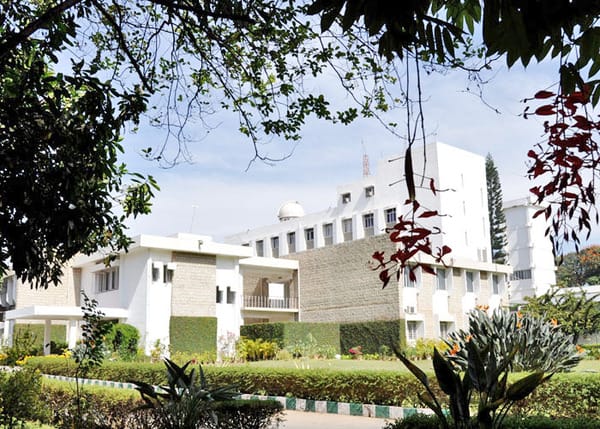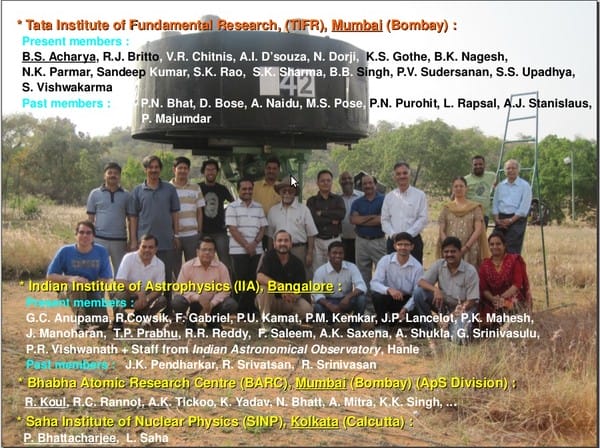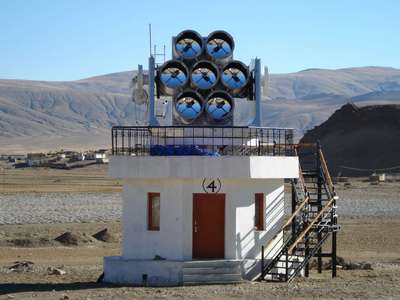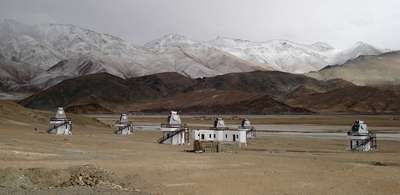High mountains, deep mines and pristine particles – that’s where you’ll find yourself or lose yourself to the basic sciences of “Astrophysics and Astronomy” and their endless possibilities. “For the purpose of research, the collection of particles that reach the Earth from outer space needs to happen either at high altitudes or deep beneath the Earth’s surface,” says 70-year old astrophysicist Dr. Palahalli Vishwanath as he reminisces his work days spent at the best of locations that he would perhaps never have visited had work not taken him. And if that sounds exciting, then you should probably find out more about Bangalore’s Indian Institute of Astrophysics (IIA) and acquaint yourself with the work being done at the Institute.

The Indian Institute of Astrophysics. Pic courtesy iiap.res.in
A brief history of IIA
Astronomy is one of the most ancient of sciences. Seems like we started gazing at the sky even before we found our footing on Earth! The Indian Institute of Astrophysics itself has a history that is nearly two centuries old!
It all started with the building of an observatory in Madras in 1792 by Sir Charles Oakeley (then Governor of Madras under East India Company); an offshoot of this observatory came to be established in Kodaikanal in 1882, as the fields of research became more dynamic and explorative. in 1968, a new field observatory was started at Kavalur for stellar spectroscopy and photometry.
Expansion of activities and interests led to the eventual formation of the new Optics, Electronics and Data Analysis centre at Bangalore and the setting up at Gauri Bidanur of a large low frequency array for studies of galactic and extragalactic structure. In 1971, the former Astrophysical Observatory was converted to an autonomous research Institute wholly financed by the Government of India, to be known henceforth as the Indian Institute of Astrophysics. [SRC: IIA website]

The team involved in Testing the HAGAR telescope at Hanle, Ladakh
Pic courtesy: Richard Britto (European Cosmic Ray Symposium, Turku, Finland)
Passion that is ageless
But how to inspire interest in a subject that is believed to be largely esoteric? Once again, it is Dr. Vishwanath, who has been and still is researching the fields of Astrophysics and Astronomy, who provides a pertinent perspective.
“It is very important that students are exposed to scientific experiments and news in these areas earlier on in their career… we need the younger generation – especially in India where they seem to get lost in the mad rush for engineering/ medical careers – to consider the field of pure sciences,” he says, optimistically adding that the youth are becoming, albeit slowly, aware of these subjects The IIA provides considerable encouragement to those with a genuine interest to pursue a career with the Institute.
Where we stand and what we need
Progress in the field of pure sciences is a collaborative effort involving scientists from countries all over the world, and astrophysics is no exception. IIA has been a qualitative part of most recent accomplishments in the field :
- The completely indigenous telescope ‘HAGAR’ (High Altitude GAmma Ray) built at Hanle in Ladakh at an altitude of 4300 m in collaboration with TIFR – This place, Hanle, was chosen because of the very good observation conditions. IIA has had the highest optical telescope in the world at Hanle since more than a decade.
- IIA is a part of the international team that is building the next generation 30-metre telescope at the Mauna Kea volcano in Hawaii.
- AstroSat – This is a multi-wavelength astronomy mission on an IRS-class satellite to be launched by the Indian launch vehicle PSLV from the Sriharikota centre later this year (2013). AstroSat will carry 5 payloads, one of which – comprising twin Ultraviolet Imaging Telescopes (UVIT) – is being built by researchers at IIA.
These are only a few examples that defines IIA as one of the best research institutes world-wide.

The array of high energy gamma ray telescopes.
But is India moving towards realisation of its full potential in the field? Dr. Vishwanath observes that there is a certain disparity between the way universities work in the western countries and in ours. In the west, students gain confidence and basic know-how of these subjects even before they make a career choice. Therefore, the number of students and even their ability to experiment in the field is high. In India, the lack of interaction between universities and research institutes make the existing opportunities difficult for students to identify or cope with if they do opt for the same; this is one of the reasons most of Phd students in India opt for theoretical research rather than experimental research. Inspite of the differences and lack of confidence levels, however, we do produce some of the best scientists.
GETTING INTO IIA
Common entrance exams like JEST, Gate, CISR-Net can get you into IIA after a personal interview with the faculty at IIA spread over two days.
Apart from the Regular Phd program, they offer an Integrated Phd that BSc students are eligible to apply for; this also saves them a year (M.Sc. plus Phd in 6 years instead of seven years if you did them separately)
There is also an integrated M.Tech program that is offered in the field of Astronomical Instrumentation – this is for those who are passionate about optics and designing instruments.
Taking Astrophysics to many
Dr. Vishwanath has authored a Kannada book on the God-particle called ‘Kana Kana Deva Kana’. “I wish to be able to take this science even to those who do not have access to much of information on the net, as a result of the language barrier.”
“I am 70 years old and am still involved in research; this excites me but I would be even more excited to see the younger generation taking over from me.”
While on the topic of younger generations, media and TV, he surprises me with his example of the TV series ‘Big Bang Theory’ explaining how such efforts drive a wide reach of astrophysics/astronomy in the west. “They have a successful TV sitcom that drives focus on these subjects in a sense, by packaging jokes and innuendo that only a physicist would understand. So how many of us in India who watch this will be able to make sense of it, even though it’s just normal everyday interactions amongst five teen physicists?”

The Indian Astronomical Observatory, Hanle, Ladakh
Follow your interest
But despite the lack of popular attention to these disciplines in our country, there are people drawn to it under various circumstances or inspiration. Take Amit Shukla from Kanpur, UP for example. Amit became interested in Astronomy and Astrophysics as a small kid, spending most of his evenings stargazing from his rooftop, “thanks to the power shedding problems” in his town. He is also grateful for the encouragement received from his academically inclined family that nurtured his interest.
Amit holds an MSc in Space sciences from the IUCAA, Pune University. “Professor. A. N. Ramprakash has been a great source of inspiration and knowledge. Since my MSc, there has been no looking back and no stopping me from wanting to pursue research in the field.” IIA has given him the opportunity to explore all three aspects of research – theoretical, experimental and instrumentation- and he is most interested in Experimental Research.
“We are trying to understand what these jets are composed of,” says Amit as he excitedly talks about his research work and shares some pictures from his thesis on Galactic black holes (Research field – Extragalactic Astronomy and Cosmology) that accrete matter into themselves. He uses data collected by the observatory in Ladakh and Himalayas to analyse the composition of jets of radiations on either side of the accretion discs (black holes).
RESEARCH AT IIA
Researchers at IIA are currently busy analysing and building models of various spatial objects and you can’t help wondering if outer space is the most happening place! Some of the things they are looking at:
- Pulsating stars and their formation – A pulsating star is found in its shifting spectrum because its surface periodically moves toward and away from us, with the same frequency as its changing brightness. (SRC: http://en.wikipedia.org/wiki/Variable_star)
- Megallanic Clouds – They orbit the Milky Way and their gravity has affected the Milky Way as well, distorting the outer parts of the galactic disk.
- “Solar Physics” – Two research students from IIA are involved in building the satellite based telescope ‘Aditya’ which is due to be launched in December 2015. It is a coronograph that will provide imageries of the corona of the sun. Unlike earth-based telescopes this can process images even during the day and its motion will mean spanning dimensions and distance.
In conclusion, as Dr. Vishwanath says, it is time to stop clinging to standard practices and delve into the world of exploration. That’s the joy of being in this field – it is an intellectual adventure. Unlike mainstream careers, where you have preset ag
endas and objectives, here, there are no concrete end goals (or applications) that are clear from the very outset.
“Einstein did what he did for fun, he enjoyed doing it. Who knew the innumerable applications of his theories and experiments as we know it in the real world now?” says the researcher. If that beckons you and you would like to explore the world of Astronomy and Astrophysics, you should just consider a research stint at the IIA – it is one of the world’s best and it’s right here in namma Bengaluru!⊕